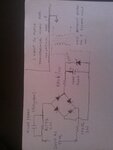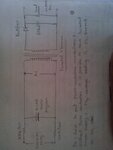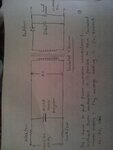chirag2239
Member level 3
Hello,
I have created a transformer which would be used in my power supply design. I have designed a supply by using just a capacitor of 0.1uF, 400V which is polyster capacitor, a bridge, resistor of 630k/2W in series and then zener diode of 6.3V,1W in series with 330k/1W resistor. Then I have heard that if this circuit will work then we cannot have isolation between input and output. so I have a risk of electric shock. So I want to put a isolation transformer that is generally used in mobile phone charger and SMPS for isolation.
So I have just created it and now I am confused that I have designed it for 240AC 50Hz input and now I am going to use it after bridge for isolation. So how do I test it?
Is there any process to test the SMPS transformer that is it working or not? Can I use it after the bridge which is DC voltage and I have applied 240V AC to bridge?
I have attached my schematic and in this schematic I have mentioned my questions that I want to do.
Kindly help me to solve my problem.
Thanks.
Chirag
I have created a transformer which would be used in my power supply design. I have designed a supply by using just a capacitor of 0.1uF, 400V which is polyster capacitor, a bridge, resistor of 630k/2W in series and then zener diode of 6.3V,1W in series with 330k/1W resistor. Then I have heard that if this circuit will work then we cannot have isolation between input and output. so I have a risk of electric shock. So I want to put a isolation transformer that is generally used in mobile phone charger and SMPS for isolation.
So I have just created it and now I am confused that I have designed it for 240AC 50Hz input and now I am going to use it after bridge for isolation. So how do I test it?
Is there any process to test the SMPS transformer that is it working or not? Can I use it after the bridge which is DC voltage and I have applied 240V AC to bridge?
I have attached my schematic and in this schematic I have mentioned my questions that I want to do.
Kindly help me to solve my problem.
Thanks.
Chirag


